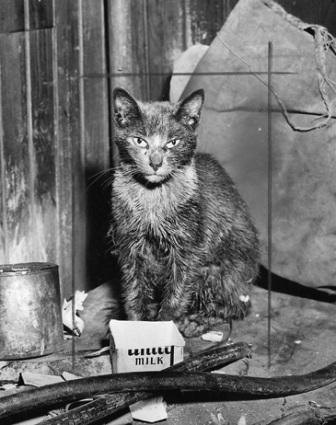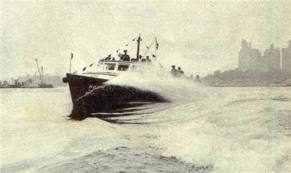
Weighing 20 pounds and standing about one foot tall, Susie was a jumbo cat. She was also the terror of the rats on the Kerr Steamship Company pier at the foot of 57th Street in the Bay Ridge section (now called Sunset Park) of Brooklyn. Susie would often kill up to 10 rats in a week; her record was eight rats in four hours.
It was rat hunting that got Susie into deep trouble on July 14, 1946. According to news articles from Brooklyn, Pittsburgh, and even Toledo, Susie was chasing a rat that tried to escape the menacing feline by diving from the pier into the New York Bay.
Susie dove in right after the drowning rat, determined to make the kill. When she surfaced, she came up under the pier and had to scramble onto a crossbeam just above the high tide water level to await rescue. The fate of the rat is unknown, although my bet is on Susie.
For five days, workmen on the piers tried to rescue Susie, but to no avail. In desperation, the men called the New York Harbor Police, who thought it best to wait for low tide before attempting a rescue.
Two workmen–Vincent Caramico, a dock handyman, and Peter Arnao, a tractor boss—sensed that Susie was getting hungry, so they decided to take matters into their own hands. Using a crane and three 20-foot planks, they were able to reach up under the pier and rescue the cat.

Gaunt, soggy, and covered in grease, Susie was too exhausted at first to eat the milk and fish the workmen provided. “Let her eat and in a couple of days she’ll be back to her normal pounds,” Caramico told reporters.
The men said they named Susie the “King of the Wharf” when she first arrived in Bay Ridge, and decided to continue calling her “King” even after discovering that the feline was female.
The M/S Høegh Silverstar

According to the workmen, Susie arrived at the Kerr Steamship pier in November 1945 on a ship that had originated in India. Based on my research, including voyage records from the Norwegian National Archives, it is most likely that Susie arrived in Bay Ridge, Brooklyn on November 12, 1945, on the M/S Høegh Silverstar.
Kerr Steamships Limited was the general agent for the Silver-Høegh Line, which operated freight services and accepted cargo for ports in Egypt, India, Pakistan, and the Persian Gulf. The Høegh Silverstar departed from Bombay, India, on October 15: I have a very strong feeling that Susie the king rat killer was onboard doing rat duty for Captain Alf Slaatten as the ship made its way to Bay Ridge.
1936: The Year of the New York City Swimming Pool
Exactly ten years before Susie took her unexpected swim in the New York Bay, more than 3,000 children and adults attended the opening events for the Sunset Play Center and outdoor swimming pool at Sunset Park. The Sunset Play Center featured an Olympic-size swimming pool that had diving and wading pools and a one-story brick bath house, and could accommodate 4,850 swimmers.
Following on the heels of an oppressive heat wave, the grand-opening of the public pool was a refreshing event for the Brooklyn Bay-area residents.

The Sunset Play Center pool was one of 11 immense outdoor pools opened in the summer of 1936 in a series of grand ceremonies presided over by Mayor Fiorello LaGuardia and Park Commissioner Robert Moses. All of the pools were funded by the Works Progress Administration (WPA), one of many New Deal agencies created in the 1930s to address the Great Depression.
The day-long opening events featured parades, blessings of the waters, swimming races, diving competitions, appearances by Olympic stars, and performances by swimming clowns. These festivities continued well after dusk, with Hizzoner pulling the switch to turn on each pool’s spectacular underwater lighting as a grand finale.
I came across the following account in The New York Times archives, which was written by Robert Moses, an avid swimmer, after becoming Parks Commissioner in 1934. I think his words neatly summarize the tragic history of Brooklyn’s waterfront neighborhoods, which, like those of Sunset Park and Bay Ridge, were transformed from sandy beaches, rural farms, and majestic resorts to unsightly shipping and manufacturing districts:
It is no exaggeration to say that the health, happiness, efficiency and orderliness of a large number of the city’s residents, especially in the summer months, are tremendously affected by the presence or absence of adequate swimming and bathing facilities. We are providing additional wading pools for children as fast as we can…This, however, does not meet the problem of any but small children…It is one of the tragedies of New York life, and a monument to past indifference, waste, selfishness and stupid planning, that the magnificent natural boundary waters of the city have been in large measure destroyed for recreational purposes by haphazard industrial and commercial developments, and by pollution through sewage, trade and other waste…We must frankly recognize the conditions as they are and make our plans accordingly…
1880s-1910s: Yacht Clubs and Beaches
About 60 years before Susie the cat found herself in a jam under the Kerr Steamship pier at 57th Street, yacht clubs and bath houses dominated the South Brooklyn waterfront from about 55th to 60th Street (which, prior to 1894, was the boundary between the City of Brooklyn and New Utrecht).
The New York Canoe Club had a club house at the foot of 57th Street, as did the Varuna Yacht Club. The Excelsior Yacht Club was at the foot of 60th Street and the Atlantic Yacht Club owned the property between 55th and 57th. These clubs held numerous regattas in the summers, featuring ¾-mile races that were often followed by swimming matches and silly events like tub races and duck chases.

Photo ca 1890s.
For those who preferred sunbathing and swimming, John P. Stein’s Brooklyn Beach Park Hotel and Bathing Pavilion at the foot of 58th-59th streets offered 1,000 feet of sandy bathing beach “free from rocks and small stones” and “illuminated by electric light,” 1,000 bath houses, springboards, floats, shower baths, excursions in “fast Naphtha launches” (a type of pleasure craft powered by an external combustion engine) from Stein’s South Pier, and bathing at night (up to 9 p.m.).
The former Henry A. Kent mansion, a castle-like estate built for the wealthy merchant in 1855 and located between 59th and 60th streets (formerly Winant J. Bennett’s farm and today the site P.S. 314 Luis Munoz Marin School), was also on the site and known as the Brooklyn Beach Park Hotel. The Congress Park Hotel, which featured 1,000 new bath houses in 1899, also fronted New York Bay from 59th to 61st streets.

The End of an Era
By the early 1900s, the Southern Brooklyn waterfront had begun a rapid transformation. In August 1900, the Morse Iron Works and Dry Dock and Repair Company purchased the property at the foot of 57th and 58th Streets, formally occupied by the Atlantic Yacht Club, for $300,000. In June 1902, John P. Stein died following a two-year illness and the Kent mansion was purchased by developers, bringing an end to the Brooklyn Beach Park Hotel and bath houses.

On April 10, 1910, the Commissioners of the Sinking Fund approved a plan for the “improvement” of the Brooklyn waterfront from 53rd to 63rd Street. The plan included the establishment of a wharf and seven new piers. Eight years later, blocks of houses, boat houses, and piers along the water’s edge were demolished to make way for the U.S. Army Military Ocean Terminal, which extends from 58th to 65th Street between the water’s edge to Second Avenue.

Today, one can only sit on the grassy knolls of Sunset Park, close his or her eyes, and imagine what life was like before there ever was a passenger ship pier at the foot of 57th Street, when the waterfront along the New York Bay was lined with sandy beaches, yacht clubs, turreted mansions, and rural farms.



